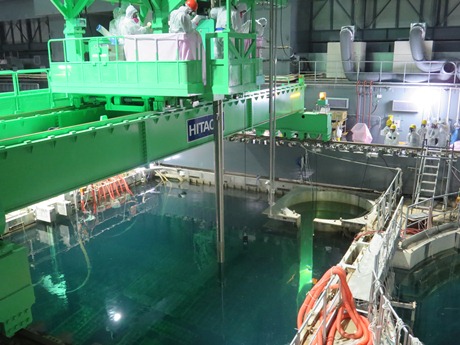Fuel removal under way at Fukushima
18 November 2013
The first four fuel assemblies have been removed from Fukushima Daiichi unit 4's storage pond, marking the start of an operation expected to be completed at the end of next year.
 |
| The work employs the same equipment and procedures as seen routinely at normal nuclear power plants (Image: Tepco) |
After completing trials using dummy fuel, Tepco reported that preparations for the removal of the first actual assembly began at 9.50am today. A fuel transport container was moved from a temporary storage location on the fifth floor of unit 4's reactor building to the fuel storage pool using the main crane. By 12.30pm, this container had been lowered into the pool ready to accept the initial fuel assembly.
The smaller refuelling crane was started up at 3.18pm, marking the start of the fuel removal process. At 3.25pm the transfer of the first fuel assembly from the storage racks into the container began and was completed within two minutes. Three further fuel assemblies had been placed in the container by 6.45pm. Tepco said that it expects to complete the removal of the first 22 unused fuel assemblies within the next two days.
When the container is full it will be sealed, lifted from the water by the main crane, placed on the service floor for decontamination and then taken through a special route to a vehicle that will move it across the site to be unloaded at the site's shared storage facility. This process will be repeated until the pool is empty. Two containers will be used in relay.
With a total of 1533 fuel assemblies in the pool (1331 used, 202 unused) the whole fuel removal operation is expected to take until the end of 2014.
Tepco will move the fuel during the day and clean dust and debris from the pool water during the night.
Unit 4 was off line for maintenance at the time of the 2011 accident with its full core load of fuel, as well as used fuel from previous operation, stored in a fuel pool at the top of the reactor building. Although this meant there was no possibility of a reactor accident at unit 4, there was a risk of the pool overheating. The stability of the pool was then reduced by major structural damage to the building caused by the ignition of hydrogen that leaked through ventilation systems shared with unit 3.
The building has since been reinforced, and thousands of tonnes of debris and rubble have been removed from its roof. A new cover has been constructed with all the fuel handling equipment of a normal nuclear power plant and inspections of the pool have shown the fuel to be undamaged and not suffering from corrosion.
Researched and written
by World Nuclear News